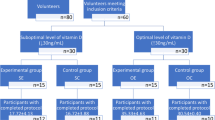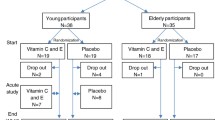Summary
This study investigated the effects of antioxidant vitamin supplementation upon muscle contractile function following eccentric exercise and was performed double blind. Twenty-four physically active young subjects ingested either placebo (400 mg; n = 8), vitamin E (400 mg; n=8) or vitamin C (400 mg; n = 8) for 21 days prior to and for 7 days after performing 60 min of box-stepping exercise. Contractile function of the triceps surae was assessed by the measurement of maximal voluntary contraction (MVC) and the ratio of the force generated at 20 Hz and 50 Hz tetanic stimulation before and after eccentric exercise and for 7 days during recovery. Following eccentric exercise, MVC decreased to 75 (4) % [mean (SE); n = 24; P < 0.05] of the preexercise values and the 20/50 Hz ratio of tetanic tension from 0.76 (0.01) to 0.49 (0.03) [mean (SE); n = 24; P<0.05). Compared to the placebo group no significant changes in MVC were observed immediately post-exercise, though recovery of MVC in the first 24 h post-exercise was greater in the group supplemented with vitamin C. The decrease in 20/50 Hz ratio of tetanic tension was significantly less (P < 0.05) post-exercise and in the initial phase of recovery in subjects supplemented with vitamin C but not with vitamin E. These data suggest that prior vitamin C supplementation may exert a protective effect against eccentric exercise-induced muscle damage.
Similar content being viewed by others
References
Armstrong RB (1984) Mechanisms of exercise-induced delayed onset muscle soreness: a brief review. Med Sci Sports Exerc 16:529–538
Byrd SK (1992) Alteration in sarcoplasmic reticulum: a possible link to exercise induced muscle damage. Med Sci Sports Exerc 24:531–536
Cannon JG, Orencole SF, Fielding RA, Meydani M, Meydani SN, Fiatarone MA, Blumberg JB, Evans WJ (1990) Acute phase response in exercise: interaction of age and vitamin E on neutrophils and muscle enzyme release. Am J Physiol 259: R1214-R1219
Davies CTM, White MJ (1981) Muscle weakness following eccentric work in man. Pflugers Arch 393:168–171
Davies KJA, Quintanilha AT, Brooks GS, Packer LA (1983) Free radicals and tissue damage produced by exercise. Biochem Biophys Res Commun 107:1198–1205
Edwards RHT, Hill DK, Jones DA, Meron PA (1977) Fatigue of long duration in human skeletal muscle after exercise. J Physiol (Lond) 272:769–778
Evans WJ, Cannon JG (1991) The metabolic effects of exercise induced muscle damage. Exerc Sport Sci Rev 19:99–125
Friden J, Lieber RL (1992) Structural and mechanical basis of exercise induced muscle injury. Med Sci Sports Exerc 24:521–530
Gerster H (1989) Review: The role of vitamin C in athletic performance. J Am Coll Nutr 8:636–643
Jackson MJ (1990) Free radicals and skeletal muscle disorders. In: Das DK, Essman WB (eds) Oxygen radicals: systemic events and disease processes. Karger, New York, pp 149–171
Jackson MJ, Lowe N, Edwards RHT (1990) Glutathione release from skeletal muscle during experimental damage. Proc Nutr Soc 49:77–81
Jakeman P, Maxwell S, Rowbottom D, Grimes E (1993) Effect of vitamin supplementation on muscle function after eccentric exercise. J Physiol (Lond) 459:72 P
Kagan VE, Kakalova RA, Rangelova DS, Stoyanovsky DA, Koyanova GM, Wolinski I (1989) Oxidative stress leads to inhibition of calcium transport by sarcoplasmic reticulum in skeletal muscle. PSEBM 190:365–368
Kugelberg E, Lindegren B (1979) Transmission and contraction fatigue of rat motor units in relation to succinate dehydrogenase activity of motor unit fibres. J Physiol (Lond) 288:285–300
Lew H, Pyke S, Quintanilha A (1985) Changes in glutathione status of plasma, liver and muscle following exhaustive exercise in rats. FEBS Lett 185:262–266
Malech HL, Gallin JI (1987) Neutrophils in human diseases. N Eng J Med 317:687–694
Maughan RJ (1982) A simple, rapid method for the determination of glucose, lactate, pyruvate, alanine, 3-hydroxybutyrate and acetoacetate on a single 20-μ1 blood sample. Clin Chim Acta 122:231–240
Maxwell SRJ, Jakeman PM, Thomason H, Leguen C, Thorpe GHC (1993) Changes in plasma antioxidant status during exercise and the effect of vitamin supplementation. Free Radic Res Commun (in press)
Milne DB, Botnen J (1986) Retinol, alpha-tocopherol, lycopene and alpha- and beta-carotene simultaneously determined in plasma by isocratic liquid chromatography. Clin Chem 32:874–876
Mottonn T, Hannoen P, Seppala O, Alfthan G, Oka M (1984) Glutathione and selenium in rheumatoid arthritis. Clin Rheumatol 3:195–200
Nagy E, Degrell I (1989) Determination of ascorbic acid and dehydroascorbic acid in plasma and cerebrospinal fluid by liquid chromatography with electrochemical detection. J Chromatogr Biomed Applic 497:276–281
Newham DJ, Jones DA, Edwards RHT (1983) Large delayed plasma creatine kinase changes after stepping exercise. Muscle Nerve 6:380–385
Newham DJ, Jones DA, Clarkson PM (1987) Repeated high force eccentric exercise: effects on muscle pain and damage. J Appl Physiol 63:1381–1386
Packer JE, Slater TF, Wilson RL (1979) Direct observation of free radical interaction between vitamin E and vitamin C. Nature 278:737–738
Phoenix J, Edwards RHT, Jackson MJ (1989) Inhibition of calcium-induced cytosolic enzyme efflux from skeletal muscle by vitamin E and related compounds. Biochem J 287:207–231
Round JM, Jones DA, Cambridge G (1987) Cellular infiltrates in human skeletal muscle: exercise induced damage as a model for inflammatory muscle disease. J Neuro Sci 82:1–11
Salviati G, Betto R, Margreth A, Novello F, Bonetti E (1980) Differential binding of vitamin E to sarcoplasmic reticulum from fast and slow muscles of the rabbit. Experentia 36:1140–1141
Scherer NM, Deamer EW (1986) Oxidative stress impairs the function of sarcoplasmic reticulum by oxidation of sulfhydryl groups in the Ca2+-ATPase. Arch Biochem Biophys 246:589–601
Sjodin B, Hellsten Westing Y, Apple FS (1990) Biochemical mechanisms for oxygen free radical formation during exercise. Sports Med 10:236–245
Smith LL, McCammon M, Smith S, Chamness M, Israel RG, O'Brien KF (1989) White blood cell response to uphill walking and downhill jogging at similar metabolic loads. Eur J Appl Physiol 58:833–837
Van Beaumont W, Greenleaf JE, Juhos L (1972) Disproportionate changes in haematocrit, plasma volume, and proteins during exercise and bed rest. J Appl Physiol 33:55–61
Warren JA, Jenkins RR, Packer L, Witt EH, Armstrong RB (1992) Elevated muscle vitamin E does not attenuate eccentric exercise induced muscle injury. J Appl Physiol 72:2168–2175
Whitehead TP, Thorpe GHG, Maxwell SRJ (1992) Enhanced chemiluminescent assay for antioxidant capacity in biological fluids. Anal Chim Acta 226:265–277
Witt EH, Reznick AZ, Viguie CA, Starke-Reed P, Packer L (1992) Exercise, oxidative damage and effects of antioxidant manipulation. J Nutr 122:766–773
Author information
Authors and Affiliations
Rights and permissions
About this article
Cite this article
Jakemanl, P., Maxwell, S. Effect of antioxidant vitamin supplementation on muscle function after eccentric exercise. Europ. J. Appl. Physiol. 67, 426–430 (1993). https://doi.org/10.1007/BF00376459
Accepted:
Issue Date:
DOI: https://doi.org/10.1007/BF00376459




